Deserts are regions that receive less than 10 inches of rain a year. Not only are these areas dry, but most are very hot as well. Some deserts can reach temperatures of 120℉, making them unlivable for most plant species. However, some plant species have evolved and have special adaptations that make it easy for them to thrive in the desert’s harsh climate.
While there may not be enough rain for vegetation to be abundant in deserts, there is just enough for drought-resilient plants to store and use slowly over time. Cacti are some of the most common plants found in the desert due to their ability to store large amounts of water. Most plants aren’t able to live in the extremely dry desert biomes across the world, but there are still quite a few species who not only live in the desert but thrive. Let’s discover some resilient plants that can thrive in a desert.
Why are Desert Plants Important?
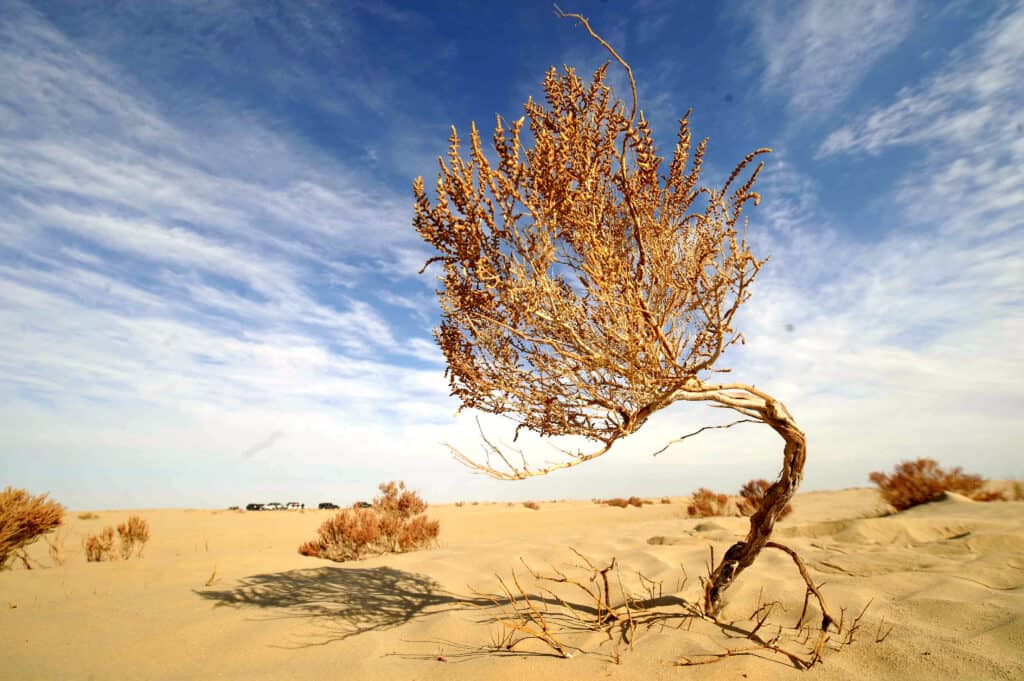
Plants in deserts require little water to adapt to the dry climate.
©iStock.com/Hans Harms
Deserts are large, hot, and dry ecosystems that don’t usually contain a lot of vegetation. The plants that do live in the desert have evolved, so they can thrive in such harsh conditions. Many plants have adapted to be better able to absorb and store water for long periods of time, making them drought tolerant or resistant.
Plants are the only living thing found in the desert, though. Animals like jackrabbits, desert tortoises, mule deer, lizards, and kangaroos rely on desert plant life for food and/or water. The desert ecosystem relies on plants for the survival of many species. Desert areas without plants often become large wastelands that can be too harsh to survive, even for most desert animals.
1. Saguaro Cactus
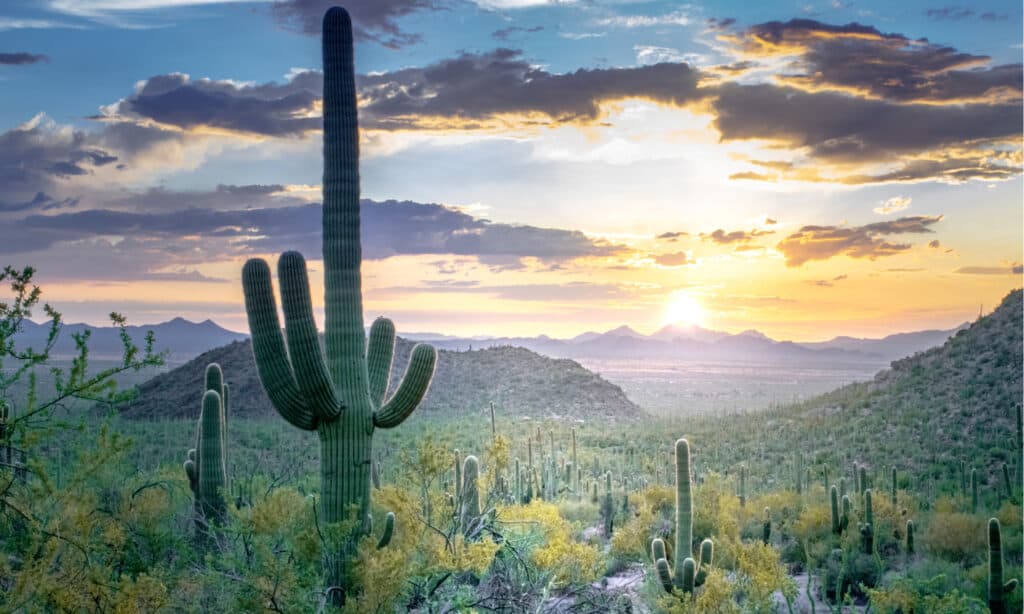
The saguaro cactus can grow over 40 feet tall and live for over 150 years.
©Nate Hovee/Shutterstock.com
Native to the Sonoran Desert, the saguaro cactus is a tall tree-like plant that can grow over 40 feet tall and live for over 150 years. This cactus can absorb and store a significant amount of water, making it thrive in dry desert conditions.
The saguaro grows large branches that extend upwards and sweet red fruits. These fruits are edible and have been used as food for thousands of years.
2. Brittlebush
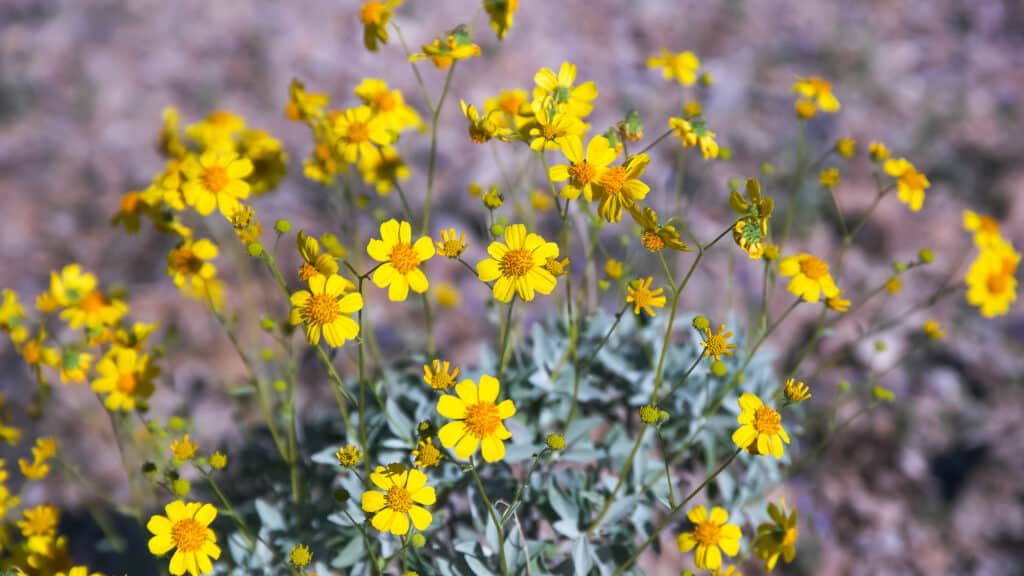
Animals like mule deer and sheep rely on brittlebush as a source of food.
©iStock.com/crbellette
Also known as brittlebrush or incienso, the brittlebush is a small desert shrub that is found in the Sonoran and Mojave Deserts. This shrub can grow up to 5 feet tall and has soft, gray oval leaves, brittle branches, and small, fragrant yellow or purple flowers.
The name brittlebush comes from the brittleness of the stems, which helps the plant use less water. The white fuzz or hairs on the leaves are used to help block the sun and act as a blanket for the stems to help keep in any moisture and protect it from the cold or heat.
3. Creosote Bush
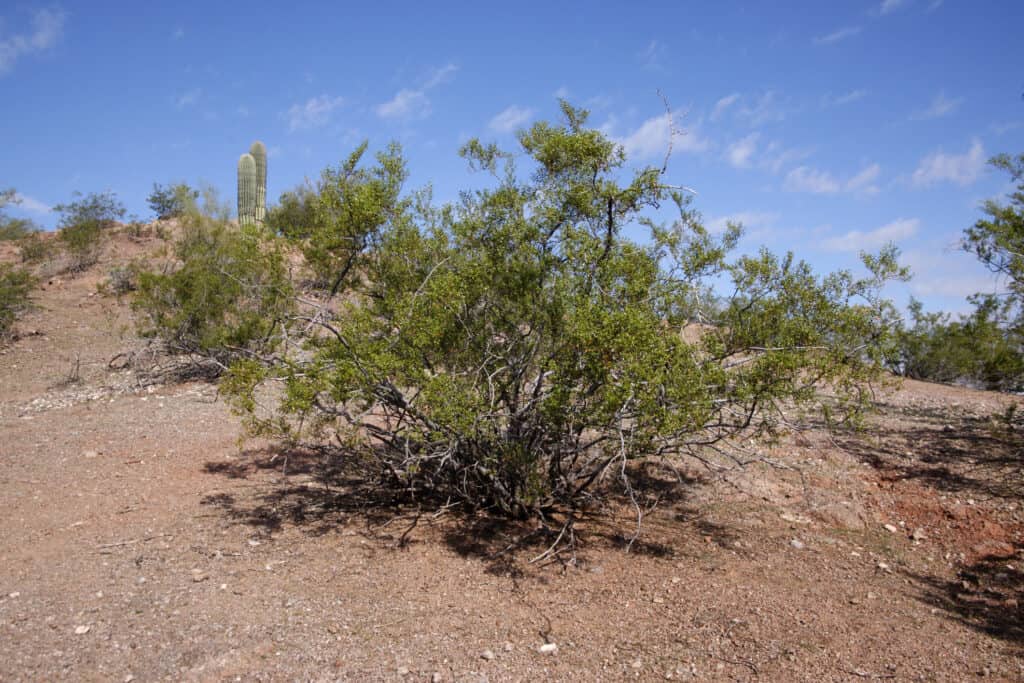
The leaves of the creosote bush have a coating on them that has a musky and earthy smell.
©iStock.com/MikeLane45
Found within the Mojave, Sonoran, and Chihuahuan Deserts of North America, the creosote bush is known for its toughness and ability to thrive in desert conditions. It is able to live for long periods of time due to its ability to inhibit the growth of nearby plants and secure more water.
The creosote bush is an evergreen shrub and can grow up to 10 feet tall. This plant has been used as a medicinal plant by Native Americans for hundreds of years and is still widely used today as a herbal medicine in Mexico.
4. Agave

The flowers of the agave plant are edible and are used in dishes like salads.
©iStock.com/camaralenta
Agave plants are native to hot, arid regions of the Americas like Mexico and the Caribbean. These plants are identified by the large circular arrangements of their long, fleshy leaves, though they can be confused with aloe or other cacti species. The succulent leaves are usually lined with sharp teeth like spines on either side, and some species can grow over 8 feet tall. Certain species of the agave plant, like the blue agave, are important economically for their use in the production of mescal liquors.
5. Tumbleweed
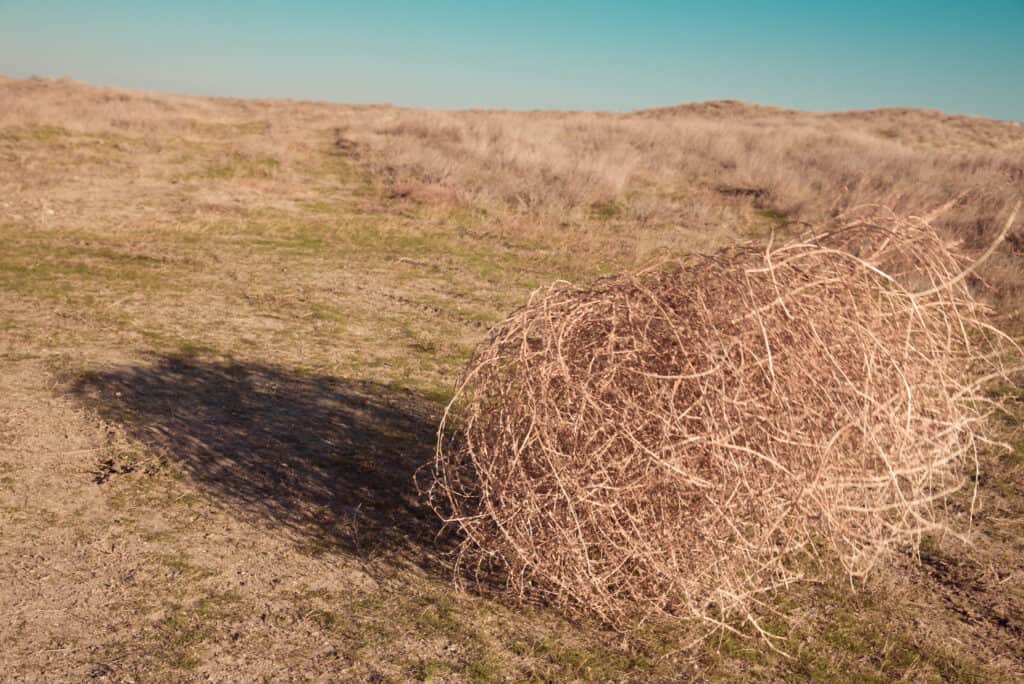
Tumbleweeds spread their seeds by using the wind and tumbling around.
©iStock.com/kornyeyeva
Also known as “Russian thistle” or “wind witch,” the tumbleweed is a known symbol for the American West. This plant is easily recognizable because it looks like the skeleton of a regular shrub. Once the plant matures and dries, it detaches from its root system and starts rolling with the wind, though dispersing seeds throughout the open desert. Tumbleweeds are dead once they detach from the roots, but their death is significant for the dispersal of their seeds or spores.
6. Joshua Tree
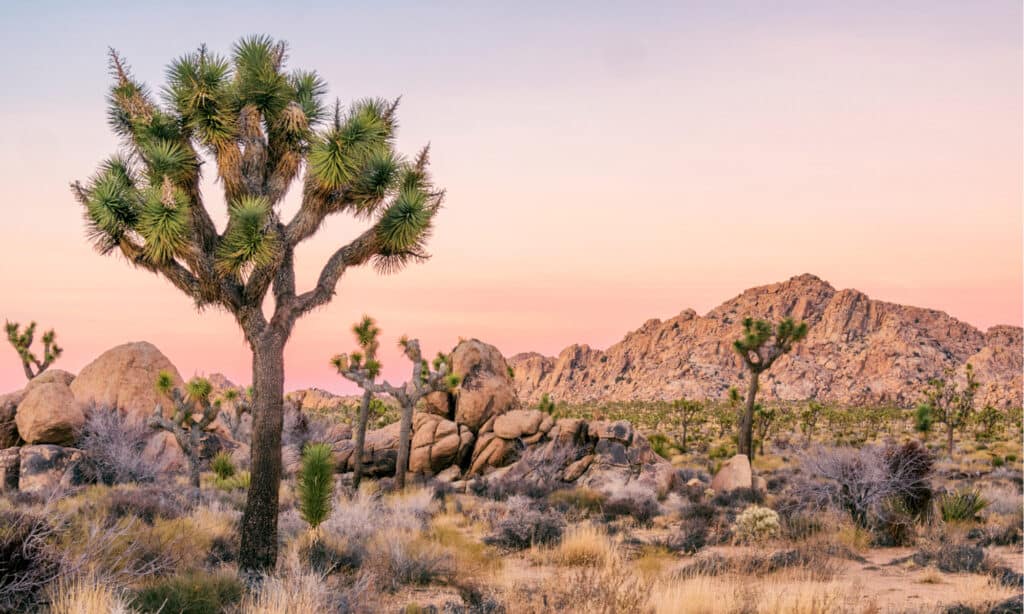
Of all the yucca plants in the world, the Joshua tree is the largest of them all.
©Dennis Silvas/Shutterstock.com
Joshua trees, also called yucca palms or yucca palm trees, are native to the southwestern deserts of North America. These plants are slow growers, only growing about 3 inches per year for the first 10 years, but that’s considered fast for a desert species! The trunk is covered with small fibers, and their thick branches have long evergreen leaves growing from the tips, which also grow small white flowers and fruit on occasion. Like most desert plants, Joshua trees don’t bloom annually; they bloom depending on rainfall at the right time.
7. Golden Barrel Cactus
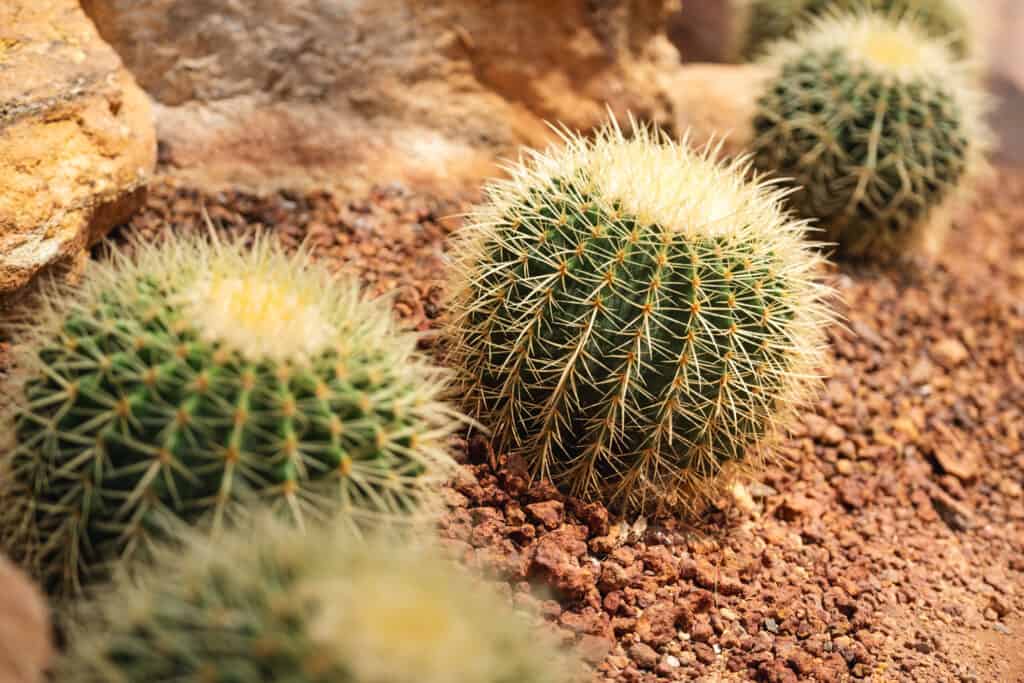
Living for up to 100 years, the golden barrel cactus begins to bloom at around 15 years of age.
©iStock.com/Farknot_Architect
Golden barrel cacti are endemic to central Mexico and are considered rare and endangered in the wild where they were originally found. These plants are spherical and large, growing to a height of about 3 feet. They can live for approximately 30 years and only start blooming after about 20 years. Sharp spines cover these cacti from head to toe and are typically long, straight, or semi-curved, and either yellow or white.
Golden barrel cacti are one of the most commonly cultivated cacti in specialty nurseries and are used as ornamental plants in rock or desert habitat gardens. They are considered easy to grow and only have a few basic requirements, like good drainage and less watering in the winter, which makes them the perfect plants to thrive in the desert.
8. Prickly Pear Cactus
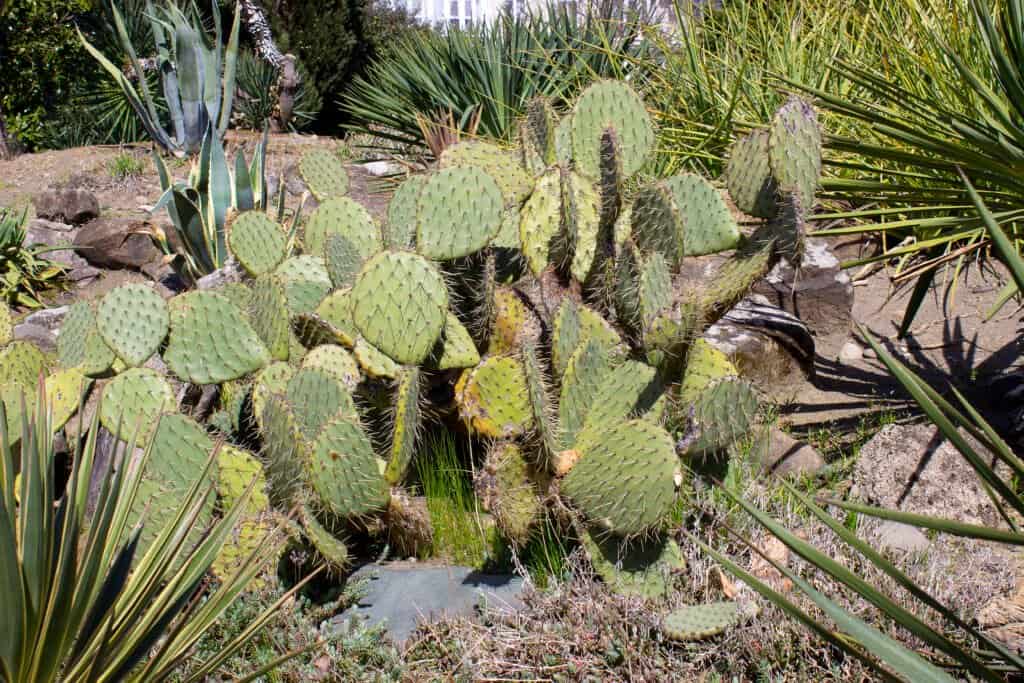
The prickly pear cactus is a large cactus that forms trunks with paddle-like segments growing off of it.
©iStock.com/Marina Krisenko
The prickly pear cactus, otherwise known as pear cactus, is a large cactus that forms trunks with paddle-like segments growing off of it. These large pads look like leaves but are actually modified branches that are either green or blue-green with evenly dispersed spines on both sides. Fruits that grow from these paddles are medium-sized red berries that are sweet and can be eaten right off the plant.
Many species of prickly pear exist, so it can vary greatly in size. Some prickly pears only grow about a foot off the ground, while others can reach over 10 feet in height and 15 feet in width. Most prickly pear species prefer to grow in coarse, well-drained soils in dry, rocky flats within mountain foothills. However, other species have adapted to higher elevations and can be found growing in juniper forests higher up the mountains.
9. Desert Sage

Elevations below 2,000 feet are the preferred environment for the desert sage.
©iStock.com/Jared Quentin
Desert sage, also known as tobacco sage, Dorr’s sage, mint sage, or purple sage, is native to the Western United States and is mainly found in the Great Basin and southern areas of the Mojave Desert. This woody evergreen shrub grows best in dry, sandy, well-drained soil and is considered drought tolerant. It can grow to 1-3 feet tall and produce flowers that are typically shades of violet, lavender, or pink.
Desert sage plants are beautiful and give off a lovely mint smell when handled and remain on the plants for weeks or months after flowering, making them a favorite among gardeners. They require very little water and are very tolerant to extreme hot and cold temperatures.
10. Desert Lily
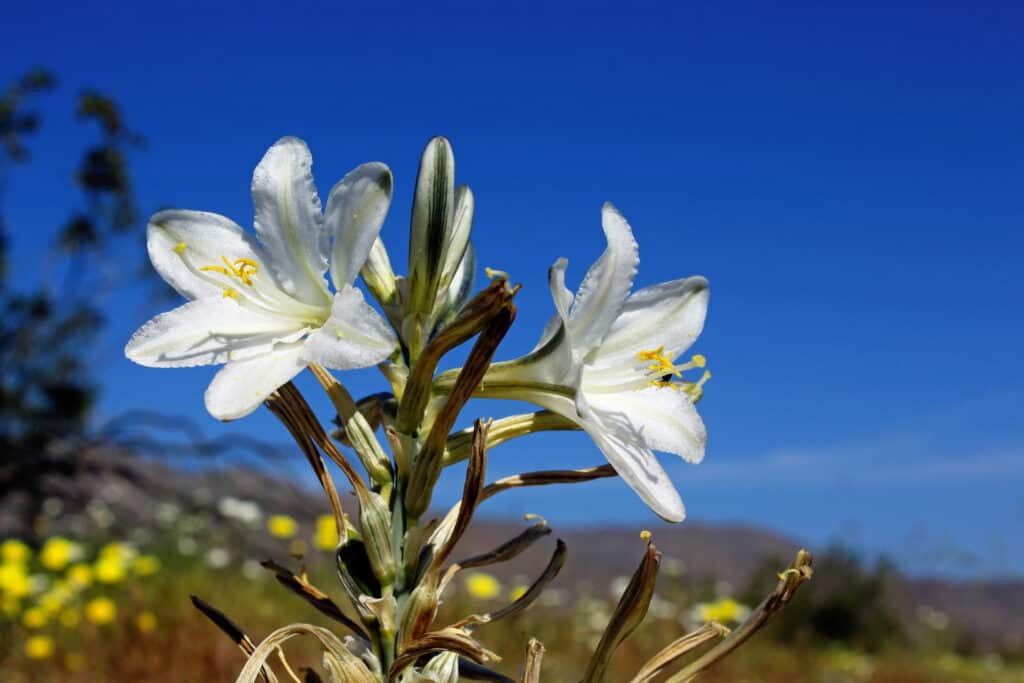
Rabbits, hares, and other plant-eating desert-dwelling animals use the desert lily flower as food.
©iStock.com/Westranger
The desert lily or ajo lily is found in the Mojave and Sonoran Deserts in North America. The name ajo lily means garlic lily due to its edible bulb’s garlic flavor. It is a flowering plant that grows in sandy and rocky areas in the hottest, driest regions of the desert. The base of the plant is a long cylindrical stem that grows many long wavy blue-green leaves and big white flowers that can grow to almost a foot long. The stem of the desert lily can grow between 1 and 4 feet in height.
What’s Next?
- Discover the 8 Most Beautiful Deserts on Earth
- The 4 Largest Deserts in North America are Stunning
- The 9 Deadliest and Most Dangerous Deserts on Earth
The photo featured at the top of this post is © iStock.com/Nate Hovee
Sources
- Desert Museum, Available here: https://www.desertmuseum.org/kids/oz/long-fact-sheets/Brittlebush.php
- Desert USA, Available here: https://www.desertusa.com/flowers/tumbleweed.html
- National Park Service, Available here: https://www.nps.gov/jotr/learn/nature/jtrees.htm
- Gardenia, Available here: https://www.gardenia.net/plant/salvia-dorrii
Thank you for reading! Have some feedback for us? Contact the AZ Animals editorial team.







